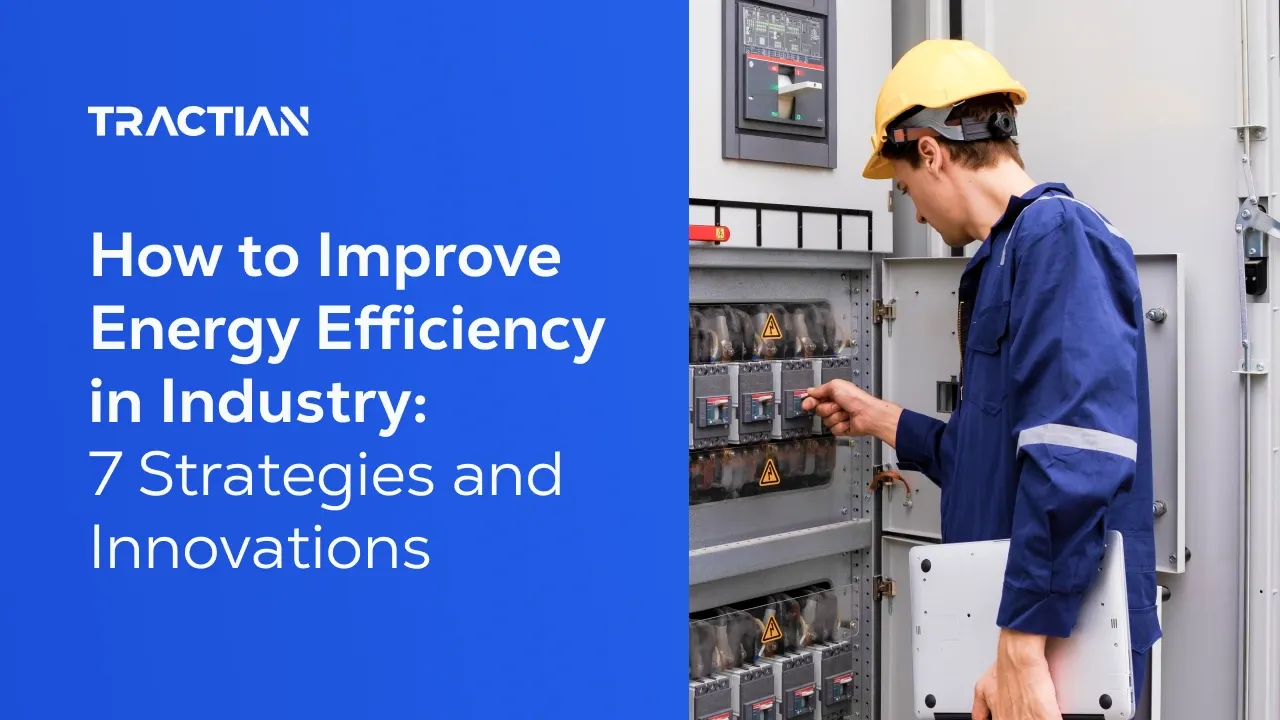Do you understand the true power of energy efficiency? - Not just saving a few bucks on the next electric bill, but forging a competitive edge that sets your company apart.
Think about it: studies by the National Academies of Science are pointing to a goldmine.
By simply implementing some cost-effective efficiency measures, like capturing all that wasted heat your machinery generates (you know, that free energy just floating around!), U.S. industries could slash their energy use by a whopping 14-22%.
That’s a seismic shift that could rewrite the rulebook on operational efficiency and sustainability for everyone.
This is a bold declaration that your company is built to thrive in the future, all while leaving a lighter footprint on our planet.
So, are you ready to unlock the hidden potential within your factory and finally conquer that energy efficiency goal?
Let’s dive in and explore eight key strategies and innovations that can turn your energy hog into a lean, mean, green machine.
1. Establishing an Energy Management Team
Building a dedicated Energy Management Team is the cornerstone of any successful industrial energy efficiency program.
This team acts as the central nervous system, responsible for strategizing, implementing, and continuously improving your efficiency initiatives.
Here’s why an Energy Management Team is crucial:
- Expertise Hub: The team brings together individuals from various departments - facilities, engineering, operations - each with their unique perspective on energy consumption within your facility. This collective knowledge ensures a holistic approach to identifying and tackling efficiency opportunities.
- Strategic Planning & Implementation: They translate your company’s energy goals into actionable plans. This involves conducting energy audits, setting specific targets, and recommending cost-effective efficiency measures. They then spearhead the implementation of these strategies, ensuring smooth integration with existing operations.
- Data-Driven Monitoring & Improvement: The team doesn’t just launch initiatives; they track progress. By closely monitoring energy consumption data and analyzing results, they can identify areas for further optimization and refine existing strategies. This data-driven approach ensures continuous improvement and maximizes your return on investment.
Think of it like this: By bringing together the right people, processes, and data analysis, the Energy Management Team transforms your energy efficiency goals from aspirations to achievable realities.
2. Conducting Comprehensive Energy Audits
Before diving headfirst into specific strategies, it’s crucial to understand your current energy landscape. This is where comprehensive energy audits come into play.
Think of them as an X-ray for your facility, revealing hidden inefficiencies and pinpointing areas ripe for improvement.
Benefits of Energy Audits:
- Identify Energy Hogs: An audit goes beyond a simple review of your energy bills. It involves a detailed on-site inspection by qualified professionals, analyzing equipment performance, production processes, and building envelope characteristics. This meticulous approach uncovers hidden energy waste, leaky systems, and areas with inefficient energy use.
- Prioritize Savings Opportunities: Not all energy-saving measures are created equal. Audits categorize identified inefficiencies based on their impact and cost of improvement. This data-driven approach allows you to prioritize investments, focusing on areas that offer the biggest bang for your buck.
- Develop a Roadmap for Improvement: The audit report serves as a blueprint for developing a customized energy management plan. It outlines specific recommendations, cost estimates, and potential savings associated with various efficiency measures. With this roadmap in hand, you can make informed decisions about where to start and how to optimize your energy use over time.
Essentially, an energy audit is an investment in your company’s future.
Uncovering hidden inefficiencies and guiding prioritization efforts, empowers you to make strategic decisions that maximize energy savings and boost your bottom line.
3. Investing in Energy-Efficient Equipment
Remember that old clunker of a car that guzzled gas like it was going out of style?
Upgrading to a fuel-efficient model might seem like a dent in your wallet at first, but the long-term savings on gas bills speak for themselves.
The same principle applies to industrial equipment.
Investing in energy-efficient machinery and technologies is a strategic move that pays dividends for years to come. Sure, the initial cost of that new, energy-sipping machine might make you wince.
The key here is to think of it as an investment, not an expense.
Modern, energy-efficient equipment operates at peak performance, minimizing wasted energy and maximizing output.
Remember that story about Henry Ford? He understood that efficiency wasn’t just about working harder; it was about working smarter.
These new technologies embody that very principle. The benefits extend far beyond your bottom line.
By slashing energy consumption, you’re also shrinking your environmental footprint. Less wasted energy means fewer greenhouse gas emissions, a win for our planet and your company’s sustainability image.
Consumers today are increasingly environmentally conscious and showcasing your commitment to eco-friendly practices can be a powerful differentiator in the marketplace.
(Oh, and of course, it can greatly upgrade your ESG score).
Investing in energy-efficient equipment isn’t just about keeping up with the Joneses; it’s about staying ahead of the curve.
Energy Trac: Unveiling Hidden Efficiency Opportunities
So, you’re convinced about the power of upgrading to energy-efficient equipment. But how do you ensure you’re getting the most out of those shiny new machines?
Here’s where technology like Energy Trac by TRACTIAN comes in.
Think of it as a way to maximize the return on your investment in efficient equipment.
Energy Trac goes beyond simply monitoring energy consumption.
This non-invasive sensor installs in minutes and provides real-time, comprehensive data on your equipment’s performance.
It can pinpoint over 70 different types of energy inefficiencies, from overloads and imbalances to failing components.
This deep level of insight allows you to identify potential problems before they snowball into costly breakdowns, ensuring your equipment operates at peak efficiency.
But Energy Trac doesn’t stop there.
It analyzes this data to generate actionable reports, helping you not only identify inefficiencies but also prioritize solutions.
Imagine having a roadmap that guides you toward optimizing equipment performance and maximizing energy savings.
This data-driven approach empowers you to make informed decisions that contribute to a significant leap in operational excellence and environmental responsibility.
In essence, Energy Trac complements your investment in energy-efficient equipment by providing the tools and insights to unlock their full potential.
It’s a strategic move that helps you not just save energy, but use it smarter.
4. Implementing Smart Manufacturing Technologies
Forget fancy jargon, “smart manufacturing technologies” are the real deal when it comes to unlocking next-level energy efficiency.
Imagine having a team of invisible efficiency experts constantly monitoring and optimizing your operations - that’s the power of these technologies.
Here’s how it works:

Think of it as a complete transformation in how you manage energy.
Smart manufacturing technologies empower you to make smarter decisions, faster, and with a greater impact on your bottom line and the environment.
5. Optimizing Production Processes
Imagine your production process as a marathon runner.
The smoother they run, the less energy they waste. The same holds true for your operations.
Optimizing production processes, with techniques like RMC (Remote Condition Monitoring) for instance, is about taking a scalpel to energy waste and ensuring every step is as efficient as possible.
Here are some key strategies:
- Process Redesign: Sometimes, the most efficient path isn’t always the most obvious one. By re-evaluating and redesigning production processes, you can eliminate unnecessary steps or consolidate them, leading to a significant reduction in energy consumption. Think of it as streamlining your workflow for maximum efficiency.
- Waste Reduction is Efficiency Gained: Waste in any form, from materials to energy, is a drain on resources. Lean manufacturing principles like eliminating waste and minimizing non-value-added activities are crucial for energy efficiency. By focusing on getting things done right the first time, you not only reduce waste but also the energy used to generate that waste in the first place.
The benefits are two-fold: a healthier bottom line and a stronger commitment to sustainability - a win-win for any business looking to dominate the competitive landscape.
6. Utilizing Renewable Energy Sources
Let’s face it, relying solely on the grid can feel like being tethered to an unpredictable and expensive energy source.
But what if you could tap into the limitless power of the sun or the steady strength of the wind to fuel your operations?
Integrating renewable energy sources like solar and wind power isn’t just an E Social G effort and a eco-friendly badge of honor; it’s a strategic move with serious financial muscle.
Here’s why going green with renewables is a win-win:
- Sustainable Future, Secure Future: Transitioning to renewables isn’t just good for the planet; it’s good for business continuity. By diversifying your energy mix, you become less susceptible to price fluctuations or supply disruptions in the traditional energy market. Think of it as building a more secure and sustainable future for your operations.
- Leading the Sustainability Charge: Consumers are increasingly environmentally conscious, and showcasing your commitment to clean energy can be a powerful differentiator. Embrace renewables and watch your brand reputation soar as a leader in sustainable practices.
Sure, the initial investment might raise an eyebrow, but the long-term benefits are undeniable.
Reduced carbon footprint, energy independence, and significant cost savings - these are just a few of the rewards that come with harnessing the power of renewables.
7. Regular Maintenance and Equipment Upkeep
They may not wear capes, but regular preventive maintenance and equipment upkeep are the unsung heroes of the energy efficiency game.
Think of them as your operation’s secret weapon, silently working behind the scenes to keep things running smoothly and efficiently.
Here’s how this unsung duo saves the day:
- Prevention is Key: Just like a car running on fumes, poorly maintained equipment works harder than it should, guzzling energy in the process. Regular maintenance catches potential problems before they snowball into energy-draining breakdowns. Think of it as preventative care that keeps your equipment operating at peak efficiency, using only the energy it needs to get the job done.
- Efficiency All Along the Lifespan: Well-maintained equipment isn’t just about avoiding hiccups; it’s about maximizing performance over the long haul. By keeping your machines in tip-top shape, you ensure they continue to operate efficiently throughout their lifespan. This translates to less energy wasted and, in turn, significant cost savings.
Future Trends in Industrial Energy Efficiency
By 2030, the market is projected to explode at a scorching 8.6% CAGR - that’s a fancy way of saying get ready for a massive shift towards smarter, leaner energy use.
Here’s a sneak peek at what’s on the horizon:
- Tech Takeover: Advanced technologies like AI and machine learning are poised to become the secret sauce of industrial efficiency. Imagine systems that not only monitor energy use but also predict and prevent inefficiencies before they even happen. We’re talking about trends like AI-assisted maintenance, for instance.
- Retrofitting Revolution: Emerging economies, particularly in the Asia Pacific region, are leading the charge in retrofitting existing infrastructure for energy efficiency. Think of it as a breath of new life for older facilities, but with a focus on cutting-edge efficiency measures.
- Democratizing Energy: The rise of energy storage and community energy ownership paints a picture of a more collaborative energy landscape. Imagine a future where industrial facilities can not only generate but also store and share clean energy, promoting a more sustainable and efficient ecosystem for everyone.
Remember, the key to unlocking this future lies in building a rock-solid foundation of efficiency today.
By maximizing the return on your current energy investments, you’re not just saving carbon; you’re laying the groundwork for a sustainable industrial revolution.
Conclusion
The path to industrial energy efficiency is a clear one: build a strong foundation with an Energy Management Team and Audits, then leverage smart technologies and optimized processes.
Embrace renewables and prioritize equipment upkeep to unlock cost savings and a lighter environmental footprint.
Implementing these strategies isn’t a nicety; it’s a necessity for a thriving, sustainable future.
So, take charge, unleash your inner efficiency champion, and join the movement towards a greener, more competitive industrial landscape.


